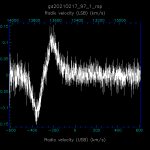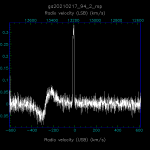Problematic Data & Key Dates
Systematic Standard Intensity Increase/Decrease
On May 29th, 2021, 3db attenuators (pads) were removed from the signal path. After this change, it is apparent that Ū’ū standards gave, in general, a higher peak values (10 to 20%) compared to previous data for both the 1000MHz and 250MHz bandwidth modes. The 3db attenuators (pads) were replaced on July 9th, 2021.
ACSIS issue/IF selection
As of April 30th 2021 (HST) the observatory’s advice to users is that MSBs utilising the second spectral region when observing with `Ū`ū or `Āweoweo have the IF is set to <5.5GHz when combined with a backend of 1000MHz and an IF <5.375GHz with a backend of 250MHz. This is due to an issue with the backend spectromter ACSIS (a broken LO2 synthesizer). Observations with IFs greater than these values will fail in our system. Reminder that noise will vary as IF – increasing to lower IF values. For estimates on the increase noise users should look at the Heterodyne ITC where it is possible to specify the IF and sideband (found under Receiver information). See: ACSIS-user-advice-November2021.
Users are additionally requested to be clear about the calibration they request for observations by specifying in the notes. Currently standards at both 250MHz backend and 1000MHz backend can be undertaken using an IF of 5GHz. For a calibration taken with an IF of 6GHz users must request either 1000MHz backend or 250MHz backend. If in doubt please reach out to your Friend of Program.
P-cygni baseline features
Significant effort has gone into removing spurious p-cygni-like baseline features that has affected some data. The issue was tracked down to the cables and connectors between the instrument and ACSIS. After much work by our instrument staff we believe we have eliminated the majority of cases as of February 24th 2021 (HST). Should you see such features in your data please reach out to your Friend of Project.
Low power NU1U
Data taken between December 28th 2020 and January 4th 2021 (HST) may have power issues on NU1U. Advice to users: If you are interested in LSB data then all is OK. If you are interested in USB data and if you have a bright signal and can use data from NU0U to assess the reliability of NU1U then it is likely OK to use this data after a comparison is made between the two polarization. If you are interested in USB data from a weak source do not include data from NU1U. To mask out pixels in a reduction see this example here. To know what pixels/polarizations/side-bands are in the raw data and reduced data see here.
Low power NU1L
Data taken between November 24th and December 28th 2020 (HST) may have power issues on NU1L. Advice to users: If you are interested in USB data then all is OK. If you are interested in LSB data and if you have a bright signal and can use data from NU0L to assess the reliability of NU1L then it is likely OK to use this data after a comparison is made between the two polarization. If you are interested in LSB data from a weak source do not include data from NU1L. To mask out pixels in a reduction see this example here. To know what pixels/polarizations/side-bands are in the raw data and reduced data see here.
Calibration issue for data with redshift/doppler correction
Data taken prior to July 21 2020 are affected by a calibration issue with the instrument. Advice to Users: Any observation taken prior to 20200721 with a redshift/doppler correction that shifts the rest frequency by more than 1 MHz should be considered unusable.
Incorrect bias setting
Data taken prior to July 15th 2020 could be impacted by a single SIS mixer having the mixer bias set to the wrong value. This was a rare issue impacting <1% of data. Advice to users: Check data prior to 20200715 if peak intensities vary widely between polarization for an unploarized source the data may be affected by this issue. Our Heterodyne Data Reduction Quick Guide provides information on reducing polarizations separately.
Comment on data flagging at CADC
Note archival `Ū`ū data impacted by the low power issue will likely have a FAIL flag attached to the data at CADC. This is simply a flag to warn users of potential issues, but the data is likely still usable if in doubt please reach out to observatory staff.




